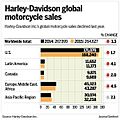User:Carolina Reinoso N/Offensive competitive strategy
Introduction[edit]
Offensive competitive strategy is a corporate strategy that consists of actively pursuing changes within an industry. Companies involved in offensive competitive strategies typically invest in technology, research & development (R&D) .This method is employed when more than one company in a market offers the same kind of product; therefore each company only receives a percentage of all sales of that category of product. It is important to know that each company has a market share so any extra effort to gain more market share against the competition is described as the offensive competitive strategy.[1]

Who uses offensive competitive strategy ?[edit]
Organizations or companies in direct competition with a rival uses offensive competitive strategies. Offensive strategies in business are focused on customers who prefer the competition , also customers who are undecided about which company , business or product is the better to satisfy their requirements.[3]
Example[edit]
There is the case of Harley Davidson against Japanese manufactured motorcycles , Harley Davidson emerged from near bankruptcy using offensive competitive strategy. That strategy includes cheaper prices , better designs and faster motorcycles. [1]
-
Example of companies that emerged bankruptcy due to the offensive competitive strategy
Using offensive competitive strategy[edit]
In order to monitor the results when applying this strategy , companies should always have a direct interaction with costumers , this would include surveys in wich are included their views and opinions about the company or the specific product that is in direct competition with ohter ones. A business should also closely follow any change in its own market share during the campaign to determine if the specific materials used in the campaign have had the intended effect.[4]
Types of Offensive competitive strategy[edit]

Frontal Attack[edit]
Frontal attack is one of the marketing strategies inspired by war tactics, this involves matching the competitor in all aspects such as product, price, place and promotion. Frontal attack is a highly risky marketing strategy , there are better chances of success if the company attacks the weakest element of the opponent, and also if the opponent is constrained in its ability to react.[5] Frontal attack is divided in 4 areas:
- Pure frontal attack: It involves matching the competitors in all aspects of marketing strategies.
- Limited frontal attack: It involves attacking in specific customer segments.
- Price based frontal attack: Every product detail is matched with the competitor.
- Research and development attack.
Flank Attack[edit]
In the course of growth and expansion, large companies commonly diversify their products and services to reach a better number of consumers. Most likely, they have a core market where they are particularly dominant, but they may not be the leader in every category.While companies may earn some profit in peripheral markets, they do not dominate them, making them ripe targets for flanking attacks.[6]There are some markets in which they are under performers and thus susceptible to flanking attacks. Flank attack can be used to replace the products of the competitors that are not so strong or to serve uncovered needs on the market.[7]
Encirclement Attack[edit]
This one is the combination of frontal attack and flank attack in which the firm need to have superior resources in order to compite , also they are surrounding with various brands so it makes difficult for the weaker competitor to defend their brand, more over the attention of the weaker competitor gets spread across various products make this whole process even harder.[8]
Bypass Attack[edit]
This strategy is also called the leapfrog strategy , basically competitors introduce new technologies in order to produce more and become competitive in the market , this also help the firm to diversify products , This strategy undertakes a challenger bypassing its opposition totally and capturing the competitor’s clients in one fell swoop.[9][10]
According to Kotler (1999) this strategy offers three lines of approach:
- Diversifying into unrelated products.
- Diversifying into new geographical markets.
- Leapfrogging into new technologies.
See also[edit]
References[edit]
- ^ a b Hitesh Bhasin. (2016). Offensive marketing – Strategy and examples. May19,2017, Marketing 91 Retrived from: http://www.marketing91.com/offensive-marketing/
- ^ Edwards J. (2015). Offensive competitive strategy. May 19,2017, de Management accounting retrived from: http://www.accountingdetails.com/offensive-competitive-strategy.htm
- ^ Heriyati P, Heruwastoand Sari Wahyuni. (2010). Offensive and Defensive Competitive Marketing Strategy: The Development of Construct & Measurements. May 19, 2017, ASEAN MARKETING JOURNAL retrived from: http://journal.ui.ac.id/index.php/amj/article/view/1999/1528
- ^ Yannopoulos P. (2011). Defensive and Offensive Strategies for Market Success. May 19 ,2017, International Journal of Business and Social Science. Retrived from: http://ijbssnet.com/journals/Vol._2_No._13_Special_Issue_July_2011/1.pdf
- ^ Victor J. Cook, Jr. (1983). Marketing Strategy and Differential Advantage. May 19,2017, Journal of Marketing . Retrived from : http://www.jstor.org/stable/1251494?seq=1#page_scan_tab_contents
- ^ Marketing school. (2012). Flanking Strategy. May 19 ,2017, retrived from: http://www.marketing-schools.org/types-of-marketing/flanking-marketing.html
- ^ MBA School. (2016). Flank attack. May 19,2017, retrived from: http://www.mbaskool.com/business-concepts/marketing-and-strategy-terms/8511-flank-attack.html
- ^ Kotler, Philip; Singh, Ravi. (1981). Marketing Warfare in the 1980s. May 19,2017, The Journal of Business Strategy; Cambridge.retrived from: http://search.proquest.com/openview/6d4255da93345077b35cf2aab2f8830d/1?pq-origsite=gscholar&cbl=1821485
- ^ SELIM HALIOUI. (2005). Marketing Walfare. May 19,2017, retrived from: http://www.madwatch.net/uploaded/dossiers/pdf/warfare.pdf
- ^ MUSADIQ A. (2013). Making decisions for strategic advantage. May 19,2017, retrived from: https://books.google.com.ec/books?id=8DP4eGl4iNAC&pg=PT219&lpg=PT219&dq=pure+frontal+attack&source=bl&ots=It_SRVGlRW&sig=rBd0YBsGvlF6q_qwmVWlgYTo3oQ&hl=es-419&sa=X&redir_esc=y#v=onepage&q=pure%20frontal%20attack&f=false

